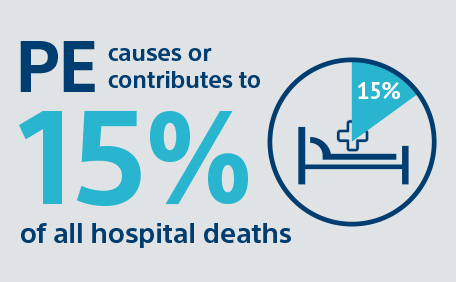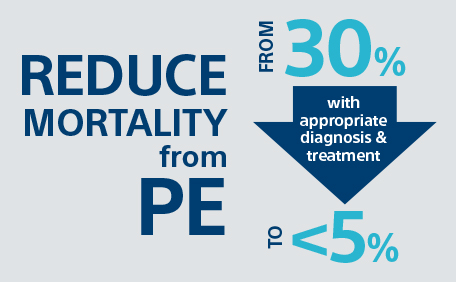Boston Scientific aims to make ultrasound-accelerated thrombolysis the new standard of care for patients with intermediate-high-risk PE. Minimally invasive, this 15-minute procedure requires lower lytic doses, limits bleeding, and has proven patient outcomes.1
Advancing standards of care for Pulmonary Embolism
Each year nearly one million patients in the U.S. and Europe are affected by Pulmonary Embolism (PE), a blood clot causing a blockage in one or more pulmonary arteries within the lungs.
In intermediate-high risk or high-risk cases of PE, the blockage may lead to a strain on the heart’s ability to pump blood through the lungs and can be fatal. The current standard of care for PE is anticoagulation, though there are disparate guidelines to direct safe and effective treatment of patients with intermediate-high-risk PE.


Every 60 seconds someone is diagnosed with Pulmonary Embolism.
It takes a united front to take action against this complex disease.
What are the main challenges in building a centre specialised in PE treatment?
Oct 08, 2020 (Time 6 min55 )
Interview with Professor Laurent Bonello, Head of ICU and PERT Team University Hospital Nord Marseille, France

Learn to diagnose and treat PE
Pulmonary Embolism is responsible for 15% of hospital deaths. Boston Scientific is committed to helping practitioners across medical specialties learn more about Pulmonary Embolism – how to diagnose it, how to treat it, and when it’s right to intervene.
Explore the Pulmonary Embolism Blended Learning Path on EDUCARE
For existing EDUCARE users, access directly the full content 🡢
Still an unregistered user? Get an overview of the course to see what awaits you 🡢
Convinced? Proceed with EDUCARE registration by following the instructions depicted in this guide 🡢
How to diagnose and choose right treatment for the patients suffering from Pulmonary Embolism
Sep 24, 2020 (Time 2 min)
Interview with Professor Nils Kucher, Professor of Angiology, Director University Clinic of Angiology, Cardiovascular Division, University Hospital Zurich, Switzerland
How to build the right pathway for patients with Pulmonary Embolism?
Sep 23, 2020 (Time 4 min)
Interview with Dr Nick Murch, Consultant Physician in Acute Medicine, Royal Free London, UK
References:
1. Tapson, Victor, et al., “A Randomized Trial of the Optimum Duration of Acoustic Pulse Thrombolysis Procedure in Acute Intermediate-Risk Pulmonary Embolism: The OPTALYSE PE Trial.” JACC: Cardiovascular Interventions Jul 2018, 11 (14) 1401-10
2. Beers, M.H., et al., The Merck Manual of Diagnosis and Therapy. 18th edition. Whitehouse Station, NJ: Merck Research Laboratories, 2006: 412-22, 427, 2081-2
3. Banovac “Reporting standards for endovascular treatment of pulmonary embolism.” J Vasc Interv Radiol, 2010; 21:44-53
Caution:
The law restricts these devices to sale by or on the order of a physician. Indications, contraindications, warnings, and instructions for use can be found in the product labelling supplied with each device or at www.IFU-BSCI.com. Products shown for INFORMATION purposes only and may not be approved or for sale in certain countries. This material not intended for use in France.
















